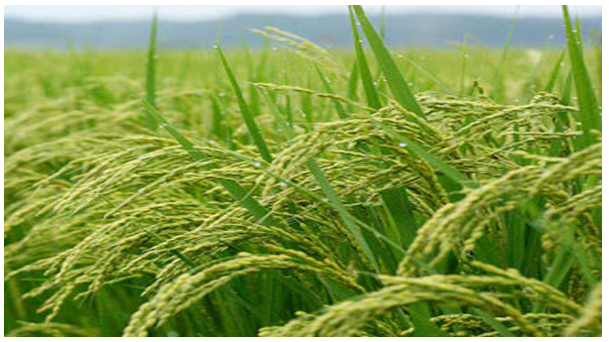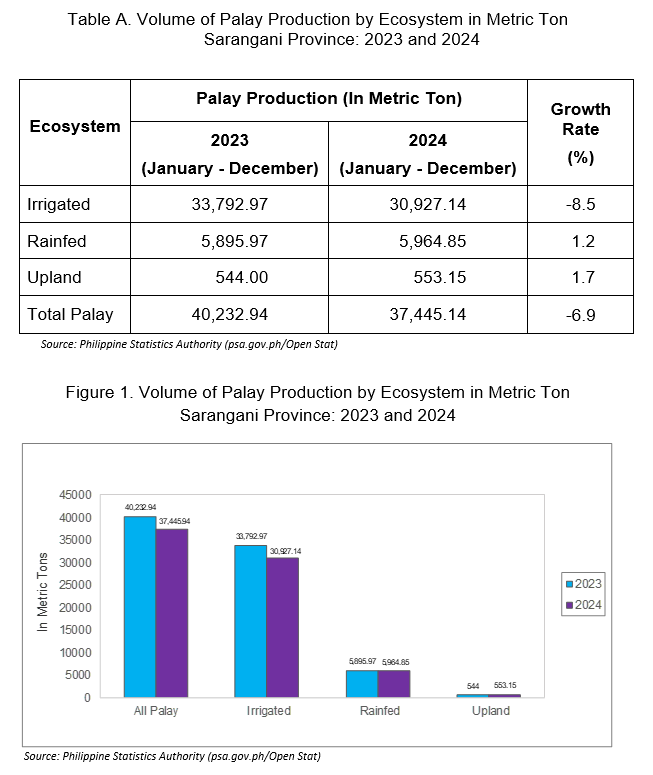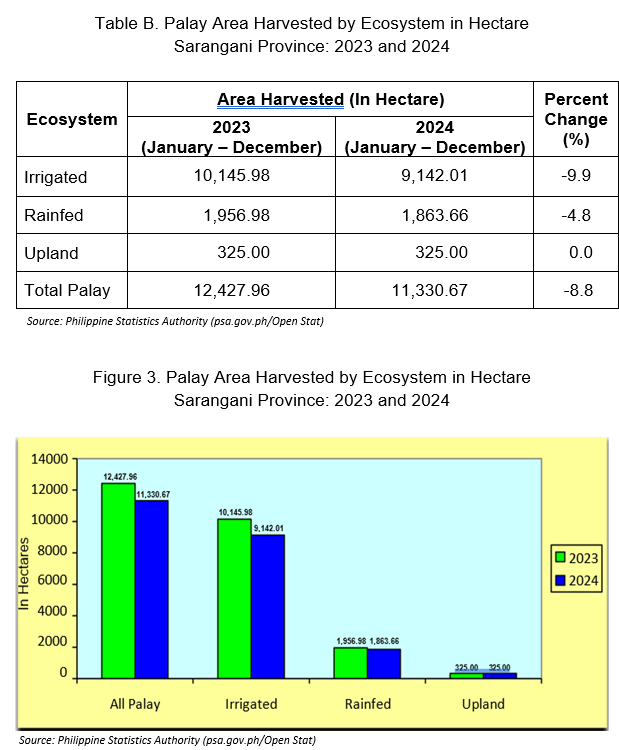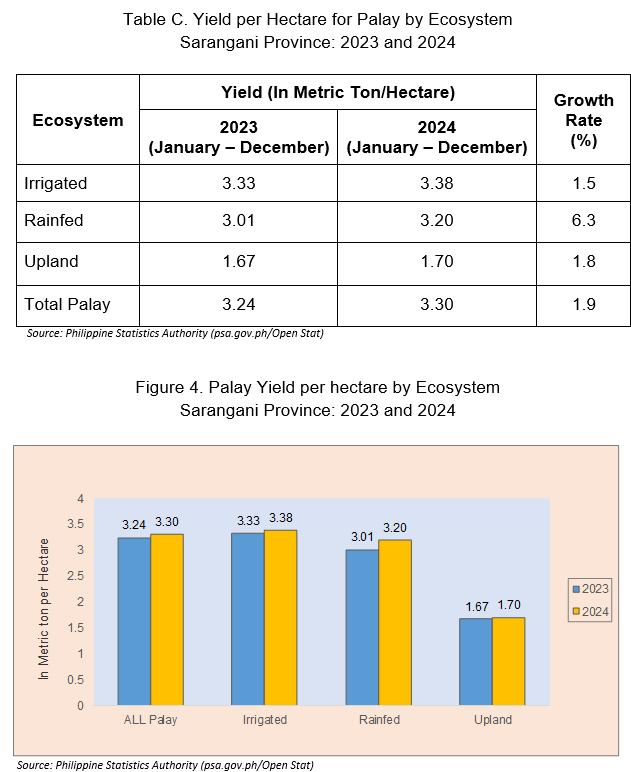
Volume of Palay Production decreases by 6.9 percent
The volume of palay production in Sarangani Province registered lower growth in 2024 compared to its level in 2023. The production was estimated at 37,445.14 metric tons, or 6.9 percent lower than the 40,232.94 metric tons recorded in 2023. Among the types of ecosystems, the volume of production for irrigated palay recorded a decrease of 8.5 percent from 33,792.97 metric tons in 2023 to 30,927.14 metric tons in 2024. Minimal increase in production was observed for rainfed palay at 1.2 percent and upland palay at 1.7 percent, with an estimated production of 5,964.85 metric tons and 553.15 metric tons in 2024, respectively. (Table A and Figure 1)

In terms of contribution to the total volume of palay production in 2024, irrigated palay had the biggest share of 82.6 percent, followed by rainfed palay which contributed 15.9 percent. Both accounted for 98.5 percent of the provincial palay production. Upland palay had the least contribution on the volume of palay production with 1.5 percent in 2024. (Figure 2)

Area Harvested reduces by 8.8 percent
The total area harvested in Sarangani Province recorded a decrease of 8.8 percent or 11,330.67 hectares in 2024 from 12,427.96 hectares in 2023. This was attributed to the decrease in area harvested for irrigated palay by 9.9 percent, from 10,145.98 hectares to 9,142.01 hectares and for rainfed palay by 4.8 percent, from 1,956.98 hectares to 1,863.66 hectares. About 80.7 percent of the total area harvested were irrigated areas and 16.4 percent were rainfed areas. Meanwhile, the area harvested for upland remained at 325 hectares in 2024 which contributed 2.9 percent share to the total area harvested in the province. (Table B and Figure 3)

Palay Yield per Hectare up by 1.9 percent
The palay yield per hectare in Sarangani Province increased by 1.9 percent, from 3.24 metric tons in 2023 to 3.30 metric tons in 2024. An increase in yield per hectare was observed in all types of ecosystems. Irrigated with 1.5 percent increase, rainfed with 6.3 percent increase and upland with 1.8 percent increase, respectively. (Table C and Figure 4)

Technical Notes
The Palay Production Survey (PPS) is one of the major agricultural surveys conducted quarterly by the Philippine Statistics Authority (PSA). This generates estimates on palay production, area, yield, and other production-related data that serve as inputs for policy making and programs on palay and rice. Specifically, the production data generated from the survey are direct inputs to the Value of Production in Philippine Agriculture and Fisheries and accordingly to the computation of Gross Domestic Product (GDP).
Moreover, the survey supports the data needs of planners, policy and decision makers, and other stakeholders in the agriculture sector, particularly the National Economic and Development Authority (NEDA), Department of Agriculture (DA) and its attached agencies such as Philippine Rice Research Institute (PhilRice), Philippine Council for Agriculture, and Fisheries (PCAF), and the public.
Palay - is the grain that becomes rice. It grows on tall grasses in wet fields, and after harvest, it's a main food for many people.
Agricultural Operator - this refers to a person who takes the technical, financial, and administrative responsibility in managing the farm, including the management and supervision of hired labor. He may work on the land himself or may employ others to work on the land. He may or may not be the owner of the land.
Farming Households - this denotes any household in which a member operates an agricultural land, either solely or jointly with other members, regardless of the aggregate area operated by the operator-members of such household.
Agricultural Land - this refers to the land devoted to or suitable for the cultivation of the soil, planting of crops, growing of trees, raising of livestock, poultry, fish or aquaculture production, including the harvesting of such farm products, and other farm activities and practices performed in conjunction with such farming operations by persons whether natural or juridical and not classified by law as mineral land, forest land, residential land, commercial land, and industrial land.
Parcel - this refers to one contiguous piece of land under one form of tenure without regard to land use. Both the contiguity and one form of tenure conditions should be met for a piece of land classified as one parcel. Contiguous means that the piece of land is not separated by natural or man-made boundaries such as river, dike, and road that are not part of the holding. A parcel may be surrounded by other lands, water, road, forest, or other features that are not part of the holding or part of the holding under different land tenure. A parcel may consist of one or more fields or plots adjacent to each other.
Land Temporarily In-Follow - these are lands which are allowed to stay idle for a period of at least one year or at most five years in order to recover its fertility, after which period it is again planted to temporary crops.
Crop Production - this refers to quantity produced and actually harvested during the reference period. It includes those harvested but damaged, stolen, given away, consumed, given as harvesters’ and threshers’ shares, reserved, etc. Palay/Corn production from seed growers which are intended for seed purposes is excluded from the survey.
Farm - a parcel or parcels of land which has a total area of at least 1,000 square meters (one-tenth of a hectare) used for agricultural purposes.
Area Harvested – this refers to the total area harvested during the reference period.
Irrigated – area with irrigation facilities supplying water through artificial means like gravity, force/power, pump, etc.
Rainfed – palay grown on this ecosystem has dikes that retain water and is solely dependent upon rainfall for its water supply.
Upland – palay grown on this ecosystem does not have amenities for standing water. It is usually located along elevated lands, along rivers, between hills, hillsides, etc., Upland type is confined not only to high places or hillsides but also to low areas having no facilities for standing water.
Yield – an indicator of productivity derived by dividing the total production by the area harvested.
Total Palay Area – is the total physical area of the palay farm operated by the sample household within the province and those located in other parts of the country.


